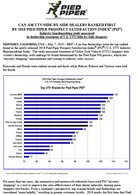Recent Press
BRP'S CAN-AM UTV/SIDE-BY-SIDE DEALERS RANKED FIRST BY 2018 PIED PIPER PROSPECT SATISFACTION INDEX® (PSI®)
Industry benchmarking study measured in-dealership treatment of U.S. UTV/Side-by-Side shoppers
May 2018
Monterey, California, USA – May 7, 2018 – BRP’s Can-Am dealerships were the top ranked brand in the newly released 2018 Pied Piper Prospect Satisfaction Index® (PSI®) U.S. UTV Industry Benchmarking Study. The study measured treatment of Utility Task Vehicle (UTV) shoppers who visited a dealership, with rankings by brand determined by the Pied Piper PSI process, which ties “mystery shopping” measurement and scoring to industry sales success.
Kawasaki and Honda were ranked second and third, while Bobcat, Kubota and Textron were tied for fourth. Mahindra and Yanmar were tied for seventh, followed by Ingersoll Rand’s Club Car brand in ninth, all scoring above the UTV industry average. Other UTV brands rated in the study were Hisun, Polaris, CFMOTO, Yamaha, John Deere, MTD Products’ Cub Cadet brand, Toro, Kymco and Ariens’ Gravely brand.
For more than ten years, the automotive and motorcycle industries have used PSI “mystery shopping” as a tool to improve the sales effectiveness of their dealer networks, turning more shoppers into buyers. From a customer’s perspective, top scoring brands and dealerships are considered “more helpful,” resulting in greater customer loyalty. 2018 marks the first time that Pied Piper has applied PSI’s fact-based approach to research and then measure the sales effectiveness of the UTV market.
The UTV market overlaps two well-established industries that previously did not compete with each other: Powersports (motorcycles, ATVs) and Outdoor Power Equipment (tractors, lawn mowers). Previously the Powersports industry focused mostly on leisure, while the Outdoor Power Equipment industry focused mostly on work. Today, for the UTV market, those boundaries are disappearing.
Differences exist today between the typical sales approach followed by Powersports dealerships and Outdoor Power Equipment dealerships. For example, Powersports dealerships are more likely to learn about customer needs, showcase vehicles through walkarounds and accessories, and promote their dealership, but also more likely to try to steer a brand’s customers to a different brand instead. Outdoor Power Equipment dealerships are more likely to provide hands-on demonstration of vehicles, including test drives, more likely to use visual aids and provide customers with printed materials, but are less likely to get customer contact information to allow follow up.
UTV customers today face an inconsistent experience when visiting dealerships. Some dealerships are professionally run, with skilled salespeople who do all they can to be helpful, but there are also locations where UTVs are sold “on the side,” by employees primarily focused on other products.
Specific sales behaviors vary considerably from dealership to dealership, and also from brand to brand, including the following examples selected from the 60+ PSI measurements:
- Demonstrate the vehicle. Dealers selling Honda, Kawasaki and Can-Am walked around a vehicle showcasing its features on average more than 90% of the time. Dealers selling Gravely, Toro and Bobcat walked around a vehicle showcasing its features on average less than 70% of the time.
- Test drive the vehicle. Dealers selling Yanmar, CFMoto and Kubota offered an immediate test drive on average more than 40% of the time. Dealers selling Polaris, Toro and Gravely offered an immediate test drive on average less than 20% of the time.
- Give reasons to buy – Resale Value. Dealers selling Club Car, Kubota and Honda mentioned high resale value as a reason to purchase on average more than 33% of the time. Dealers selling Toro and Polaris mentioned high resale value as a reason to purchase on average less than 10% of the time.
- Give reasons to buy – Service Convenience. Dealers selling Club Car, Kubota, Yanmar and Honda mentioned service convenience solutions (such as mobile “come-to-you” service or service pick-up and delivery) as a reason to purchase on average more than 30% of the time. Dealers selling Gravely, HiSun, Toro and Polaris mentioned service convenience solutions on average less than 20% of the time.
- Suggest going through the numbers or writing up a deal. Dealers selling Bobcat, Mahindra and Honda suggested going through the numbers or writing up a deal on average more than 50% of the time. Dealers selling Toro, Gravely and Yamaha suggested going through the numbers or writing up a deal on average less than 30% of the time.
- Mention availability of financing. Dealers selling Can-Am, Kubota, Honda and Yanmar mentioned the availability of financing options on average more than 65% of the time. Dealers selling Gravely, Yamaha, Toro and Kymco mentioned the availability of financing options on average less than 50% of the time.
- Ask for contact information. Dealers selling Bobcat, Kawasaki and Can-Am asked for the customer’s contact information on average more than 50% of the time. Dealers selling Cub Cadet, Kymco, Club Car and Kubota asked for the customer’s contact information on average less than 35% of the time
Some UTV salespeople are negative about the brand they are supposed to be selling. Despite their dealership carrying the brand, salespeople were most likely to mention negatives associated with Toro, Kubota and Yamaha. Some salespeople also specifically tried to steer the customer to a brand different from the customer’s preferred brand. More than 25% of the time, salespeople tried to sell Textron, CFMoto, Yamaha and Kymco customers another brand instead. In contrast, less than 10% of Bobcat, John Deere or Mahindra customers were steered to competitor brands instead.
Not only is there variation in UTV sales behaviors, but for some brands it can be difficult for customers to find online product information or even accurate dealership location information. “It’s not always easy to be a UTV customer today,” said Fran O’Hagan, President & CEO of Pied Piper. “Because the UTV market is still young, strong dealerships with skilled salespeople are an important competitive advantage for UTV manufacturers.”

